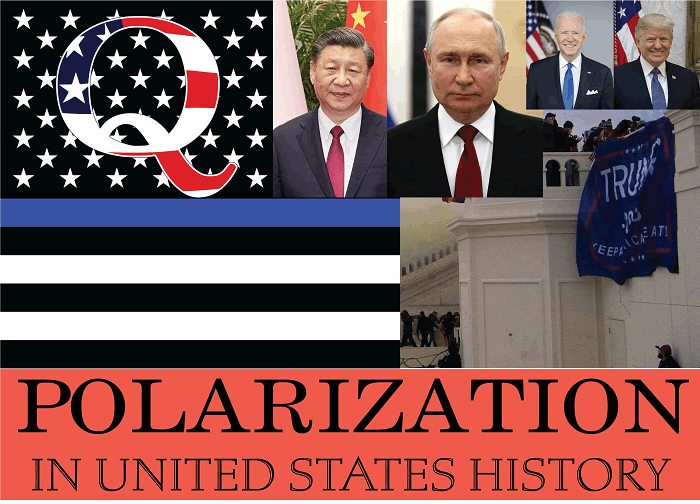 |
| Unit XVI: Polarization and Deglobalization Educational Materials |
|---|
| www.studenthandouts.com ↣ U.S. History ↣ Polarization and Deglobalization |
| Polarization Books and Films | Polarization Outlines and PowerPoints |
| Polarization Games | Polarization Pictures and Maps |
| Polarization and Deglobalization Miscellany | Polarization Worksheets |
The growing political polarization in the United States is a complex and multifaceted phenomenon characterized by increasing ideological divisions and partisan hostility between different segments of the population. Several factors contribute to this polarization: Media Fragmentation: The rise of cable news, talk radio, and social media has created echo chambers where individuals can consume news and information that aligns with their preexisting beliefs. This leads to confirmation bias, where people are more likely to accept and share information that supports their views, reinforcing existing ideological divides.
Media Fragmentation: The rise of cable news, talk radio, and social media has created echo chambers where individuals can consume news and information that aligns with their preexisting beliefs. This leads to confirmation bias, where people are more likely to accept and share information that supports their views, reinforcing existing ideological divides.Social Media and Filter Bubbles: Social media platforms often use algorithms that show users content similar to what they have previously engaged with. This can create filter bubbles, where people are exposed to a limited range of perspectives, further entrenching their existing beliefs and isolating them from differing opinions. Gerrymandering: Political gerrymandering, where district boundaries are drawn to favor one party over another, can lead to the election of more extreme candidates who cater to their party's base rather than seeking bipartisan compromises. This results in a more polarized political landscape. Party Sorting: Over the past few decades, the Democratic and Republican parties have become more ideologically homogeneous. Both Democrats and Republicans have moved right on economic and foreign policy issues, leaving social issues, such as LGBTQ+ rights, as the only dividing lines; and the rhetoric surrounding these issues is often bellicosely covered by politicians and the media. This has led to a situation where the ideological gap between the two parties has widened. Negative Partisanship: Many Americans are motivated by a strong dislike or fear of the opposing party. This "negative partisanship" can lead to a situation where people are more motivated to vote against the other party's candidates rather than for their own party's candidates. This can lead to more extreme and polarized policy positions. Economic and Cultural Factors: Growing economic inequality, cultural divides, and demographic changes have contributed to political polarization. Rural-urban divides, racial tensions, and differing attitudes on issues like immigration, gun control, and climate change, have deepened the political divide. Media Polarization: Certain media outlets have become more ideologically aligned with one major political party or the other, contributing to the dissemination of partisan narratives and further dividing the electorate. Most Americans are functioning with a narrative and information (or misinformation) dataset that is aligned to the general stance and perspective of one of the two major political parties. Primary Elections: Primary elections tend to attract the most ideologically extreme voters from each party, leading candidates to adopt more extreme positions to win their party's nomination. This can make it difficult for moderate candidates to succeed in general elections. Lack of Trust in Institutions: Declining trust in government, institutions, and the media can make people more susceptible to conspiracy theories and alternative narratives that reinforce their existing beliefs. Real and existing actual conspiracies and misinformation campaigns, both past and present, do nothing to alleviate this dire situation. Geographic Segregation: Americans increasingly live in communities with like-minded individuals, which reduces exposure to diverse perspectives and contributes to political polarization. The consequences of political polarization are far-reaching and can include legislative gridlock, a lack of compromise on important policy issues, and increased social and political tensions. Addressing this polarization will likely require a multifaceted approach, including efforts to promote media literacy, electoral reform, and efforts to encourage civil discourse and understanding between individuals with differing viewpoints. |
| UNIT I: | Early America | UNIT IX: | Discontent and Reform | ||
| UNIT II: | Colonial Period | UNIT X: | War, Prosperity, and Depression | ||
| UNIT III: | American Revolution | UNIT XI: | New Deal and World War II | ||
| UNIT IV: | New National Government | UNIT XII: | Postwar America | ||
| UNIT V: | Westward Expansion | UNIT XIII: | Decades of Change | ||
| UNIT VI: | Sectional Conflict | UNIT XIV: | New Conservatism | ||
| UNIT VII: | Civil War and Reconstruction | UNIT XV: | Into the Twenty-first Century | ||
| UNIT VIII: | Growth and Transformation | UNIT XVI: | Polarization and Deglobalization |
| www.studenthandouts.com ↣ U.S. History ↣ Polarization and Deglobalization |








